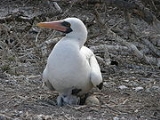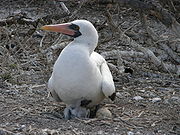
Siblicide
Encyclopedia

Sibling
Siblings are people who share at least one parent. A male sibling is called a brother; and a female sibling is called a sister. In most societies throughout the world, siblings usually grow up together and spend a good deal of their childhood socializing with one another...
s or be mediated by the parents. The evolutionary drivers may be either indirect benefits for the genetic
Genetics
Genetics , a discipline of biology, is the science of genes, heredity, and variation in living organisms....
viability of a population
Population
A population is all the organisms that both belong to the same group or species and live in the same geographical area. The area that is used to define a sexual population is such that inter-breeding is possible between any pair within the area and more probable than cross-breeding with individuals...
or direct benefits for the perpetrators. Siblicide has mainly, but not only, been observed in bird
Bird
Birds are feathered, winged, bipedal, endothermic , egg-laying, vertebrate animals. Around 10,000 living species and 188 families makes them the most speciose class of tetrapod vertebrates. They inhabit ecosystems across the globe, from the Arctic to the Antarctic. Extant birds range in size from...
s.
The word is also used as a unifying term for fratricide
Fratricide
Fratricide is the act of a person killing his or her brother....
and sororicide
Sororicide
Sororicide is the act of killing one's own sister.There are a number of examples of sororicide and fratricide in adolescents, even pre-adolescents, where sibling rivalry and resulting physical aggression can get out of hand and lead to the death of one of them, particularly...
in the human species; unlike these more specific terms, it leaves the sex of the victim unspecified.
Examples
Cattle EgretCattle Egret
The Cattle Egret is a cosmopolitan species of heron found in the tropics, subtropics and warm temperate zones. It is the only member of the monotypic genus Bubulcus, although some authorities regard its two subspecies as full species, the Western Cattle Egret and the Eastern Cattle Egret...
s, Bubulcus ibis, exhibit asynchronous hatching and androgen
Androgen
Androgen, also called androgenic hormone or testoid, is the generic term for any natural or synthetic compound, usually a steroid hormone, that stimulates or controls the development and maintenance of male characteristics in vertebrates by binding to androgen receptors...
loading in the first two eggs of its 3-egg clutch. This results in the older chicks being more aggressive and having a developmental head start. If food is scarce the third chick often dies or is killed by the larger siblings and so parental effort is distributed between the remaining chicks, which are hence more likely to survive to reproduce. The extra "excess" egg is possibly laid either due to exploit the possibility of elevated food abundance (as seen in the Blue-footed Booby
Blue-footed Booby
The Blue-footed Booby is a bird in the Sulidae family which comprises ten species of long-winged seabirds. The natural breeding habitat of the Blue-footed Booby is tropical and subtropical islands off the Pacific Ocean, most famously, the Galápagos Islands, Ecuador.- Etymology :The name booby...
(Sula nebouxii) or due to the chance of sterility
Infertility
Infertility primarily refers to the biological inability of a person to contribute to conception. Infertility may also refer to the state of a woman who is unable to carry a pregnancy to full term...
in one egg, something suggested by studies into the Common Grackle
Common Grackle
The Common Grackle, Quiscalus quiscula, is a large icterid.-Description:The long adult has a long dark bill, pale yellowish eyes and a long tail; its feathers appear black with purple, green or blue iridescence on the head, and primarily bronze shine in the body plumage...
, Quiscalus quiscula and the Masked Booby
Masked Booby
The Masked Booby, Sula dactylatra, is a large seabird of the booby family, Sulidae. This species breeds on islands in tropical oceans, except in the eastern Atlantic; in the eastern Pacific it is replaced by the Nazca Booby, Sula granti, which was formerly regarded as a subspecies of Masked Booby...
, Sula dactylatra.
In Spotted Hyena
Spotted Hyena
The spotted hyena also known as laughing hyena, is a carnivorous mammal of the family Hyaenidae, of which it is the largest extant member. Though the species' prehistoric range included Eurasia extending from Atlantic Europe to China, it now only occurs in all of Africa south of the Sahara save...
s, Crocuta crocuta, pups of the same sex exhibit siblicide more often than male-female twins. Sex ratio
Sex ratio
Sex ratio is the ratio of males to females in a population. The primary sex ratio is the ratio at the time of conception, secondary sex ratio is the ratio at time of birth, and tertiary sex ratio is the ratio of mature organisms....
s may be manipulated in this way and the dominant status of a female and transmission of genes
Gênes
Gênes is the name of a département of the First French Empire in present Italy, named after the city of Genoa. It was formed in 1805, when Napoleon Bonaparte occupied the Republic of Genoa. Its capital was Genoa, and it was divided in the arrondissements of Genoa, Bobbio, Novi Ligure, Tortona and...
may be ensured through a son or daughter which inherits this solely, receiving much more parental nursing and decreased sexual competition. Siblicidal ‘survival of the fittest
Survival of the fittest
"Survival of the fittest" is a phrase originating in evolutionary theory, as an alternative description of Natural selection. The phrase is today commonly used in contexts that are incompatible with the original meaning as intended by its first two proponents: British polymath philosopher Herbert...
’ is also exhibited in parasitic wasps, which lay multiple eggs in a host, after which the strongest larva
Larva
A larva is a distinct juvenile form many animals undergo before metamorphosis into adults. Animals with indirect development such as insects, amphibians, or cnidarians typically have a larval phase of their life cycle...
kills its rival sibling.
The theory of kin selection
Kin selection
Kin selection refers to apparent strategies in evolution that favor the reproductive success of an organism's relatives, even at a cost to the organism's own survival and reproduction. Charles Darwin was the first to discuss the concept of group/kin selection...
may be seen as a genetically mediated altruistic response within closely related individuals whereby the fitness conferred by the altruist to the recipient outweighs the cost to itself or the sibling/parent group. The fact that such a sacrifice occurs indicates an evolutionary tendency in some taxa toward improved vertical gene transmission in families or a higher percentage of the unit in reaching a reproductive age in a resource-limited environment.
See also
- Parent-offspring conflictParent-offspring conflictParent–offspring conflict is a term coined in 1974 by Robert Trivers. It is used to signify the evolutionary conflict arising from differences in optimal parental investment to an offspring from the standpoint of the parent and the offspring...
- FratricideFratricideFratricide is the act of a person killing his or her brother....
, the killing of a brother - SororicideSororicideSororicide is the act of killing one's own sister.There are a number of examples of sororicide and fratricide in adolescents, even pre-adolescents, where sibling rivalry and resulting physical aggression can get out of hand and lead to the death of one of them, particularly...
, the killing of a sister - Infanticide (zoology)Infanticide (zoology)In animals, infanticide involves the killing of young offspring by a mature animal of its own species, and is studied in zoology, specifically in the field of ethology. Ovicide is the analogous destruction of eggs. Although human infanticide has been widely studied, the practice has been observed...
, a related behaviour - Nazca BoobyNazca BoobyThe Nazca Booby, Sula granti, is a booby which is found in the eastern Pacific Ocean, namely on the Galápagos Islands where it can be seen by eco-tourists, and on Clipperton Island...
(displays obligate siblicide) - Sibling rivalrySibling rivalrySibling rivalry is a type of competition or animosity among children, blood-related or not.Siblings generally spend more time together during childhood than they do with parents. The sibling bond is often complicated and is influenced by factors such as parental treatment, birth order, personality,...
Further reading
- Michalski, R. L., Russell, D. P., Shackelford, T. K., & Weekes-Shackelford, V. A. (in press). Siblicide and genetic relatedness in Chicago, 1870-1930. Homicide Studies. Full text
- Russell, D. P., Michalski, R. L., Shackelford, T. K., & Weekes-Shackelford, V. A. (2007). A preliminary investigation of siblicide as a function of genetic relatedness. Journal of Forensic Sciences, 52, 738-739. Full text

